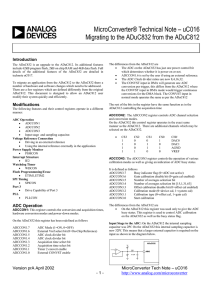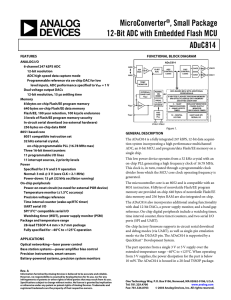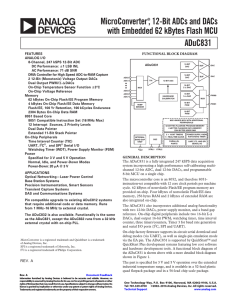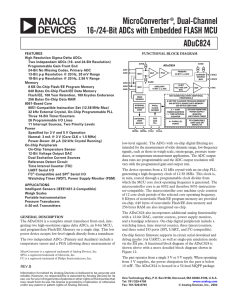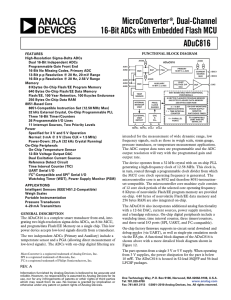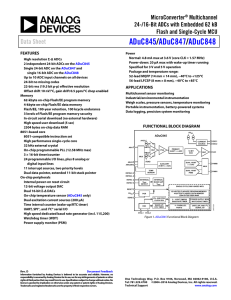a MicroConverter® Technical Note – uC020
advertisement
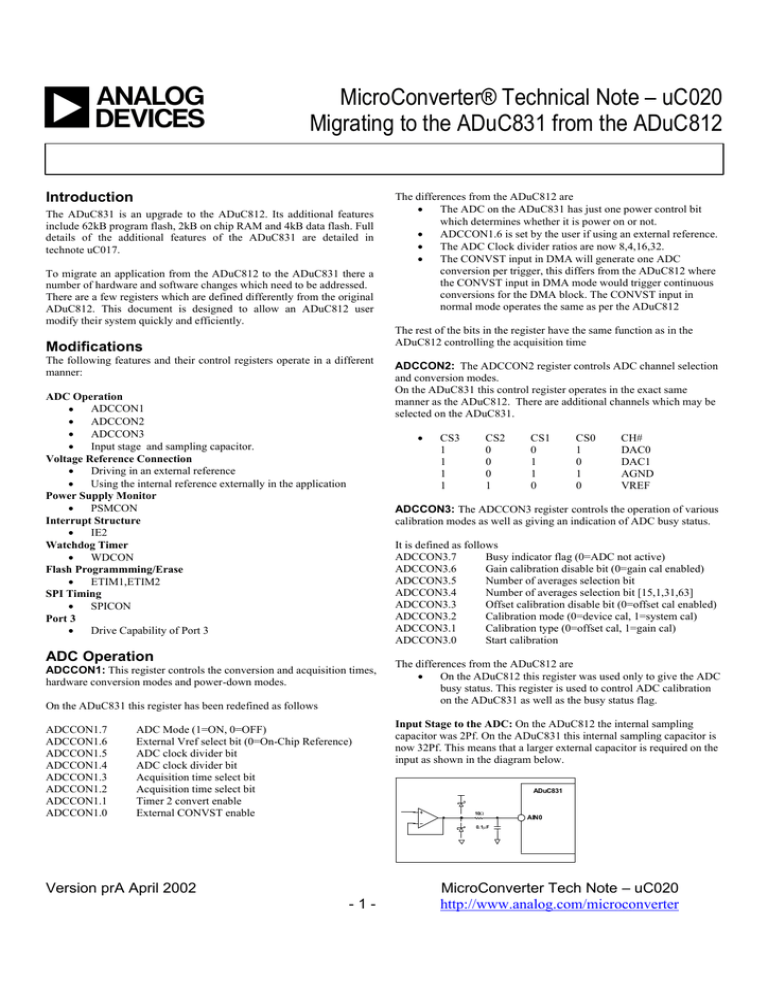
a MicroConverter® Technical Note – uC020 Migrating to the ADuC831 from the ADuC812 Introduction The ADuC831 is an upgrade to the ADuC812. Its additional features include 62kB program flash, 2kB on chip RAM and 4kB data flash. Full details of the additional features of the ADuC831 are detailed in technote uC017. To migrate an application from the ADuC812 to the ADuC831 there a number of hardware and software changes which need to be addressed. There are a few registers which are defined differently from the original ADuC812. This document is designed to allow an ADuC812 user modify their system quickly and efficiently. The rest of the bits in the register have the same function as in the ADuC812 controlling the acquisition time Modifications The following features and their control registers operate in a different manner: ADC Operation ADCCON1 • • ADCCON2 ADCCON3 • • Input stage and sampling capacitor. Voltage Reference Connection • Driving in an external reference • Using the internal reference externally in the application Power Supply Monitor • PSMCON Interrupt Structure IE2 • Watchdog Timer • WDCON Flash Programmming/Erase • ETIM1,ETIM2 SPI Timing • SPICON Port 3 Drive Capability of Port 3 • ADCCON2: The ADCCON2 register controls ADC channel selection and conversion modes. On the ADuC831 this control register operates in the exact same manner as the ADuC812. There are additional channels which may be selected on the ADuC831. • CS3 1 1 1 1 CS2 0 0 0 1 CS1 0 1 1 0 CS0 1 0 1 0 CH# DAC0 DAC1 AGND VREF ADCCON3: The ADCCON3 register controls the operation of various calibration modes as well as giving an indication of ADC busy status. It is defined as follows ADCCON3.7 Busy indicator flag (0=ADC not active) ADCCON3.6 Gain calibration disable bit (0=gain cal enabled) ADCCON3.5 Number of averages selection bit ADCCON3.4 Number of averages selection bit [15,1,31,63] ADCCON3.3 Offset calibration disable bit (0=offset cal enabled) ADCCON3.2 Calibration mode (0=device cal, 1=system cal) ADCCON3.1 Calibration type (0=offset cal, 1=gain cal) ADCCON3.0 Start calibration ADC Operation ADCCON1: This register controls the conversion and acquisition times, hardware conversion modes and power-down modes. On the ADuC831 this register has been redefined as follows ADCCON1.7 ADCCON1.6 ADCCON1.5 ADCCON1.4 ADCCON1.3 ADCCON1.2 ADCCON1.1 ADCCON1.0 The differences from the ADuC812 are • The ADC on the ADuC831 has just one power control bit which determines whether it is power on or not. • ADCCON1.6 is set by the user if using an external reference. • The ADC Clock divider ratios are now 8,4,16,32. • The CONVST input in DMA will generate one ADC conversion per trigger, this differs from the ADuC812 where the CONVST input in DMA mode would trigger continuous conversions for the DMA block. The CONVST input in normal mode operates the same as per the ADuC812 ADC Mode (1=ON, 0=OFF) External Vref select bit (0=On-Chip Reference) ADC clock divider bit ADC clock divider bit Acquisition time select bit Acquisition time select bit Timer 2 convert enable External CONVST enable The differences from the ADuC812 are • On the ADuC812 this register was used only to give the ADC busy status. This register is used to control ADC calibration on the ADuC831 as well as the busy status flag. Input Stage to the ADC: On the ADuC812 the internal sampling capacitor was 2Pf. On the ADuC831 this internal sampling capacitor is now 32Pf. This means that a larger external capacitor is required on the input as shown in the diagram below. ADuC831 10Ω AIN0 0.1µF Version prA April 2002 -1- MicroConverter Tech Note – uC020 http://www.analog.com/microconverter MicroConverter® Technical Note – uC020 Migrating to the ADuC831 from the ADuC812 a Voltage Reference Power Supply Monitor Connecting an external reference: On the ADuC812 to connect in an external reference theVref pin was overdriven. This method can still be used with the ADuC831. This allows backwards compatibility with the ADuC812. Note that ADCCON1.6 should be set to select the internal refernce if this method is used allowing the internal reference to be overdriven. Note that this method introduces a gain error which will then have to be calibrated out. PSMCON: This register controls the operation of the power supply monitor which monitors both the DVdd supply levels. The recommend method for connecting in an external reference is as shown below. This does not introduce a gain error as in the previous case. ADuC831 51? 2.5V BANDGAP REFERENCE BUFFER " 0" =Internal VREF PSMCON1.7 PSMCON1.6 PSMCON1.5 PSMCON1.4 PSMCON1.3 PSMCON1.2 PSMCON1.1 PSMCON1.0 RESERVED PSM Status bit (1=normal / 0=fault) PSM Interrupt bit Trip Point Select bit Trip Point Select bit [4.37V,3.08V,2.93V,2.63V] RESERVED RESERVED PSM Enable control (0=Off, 1=On) The differences from the ADuC812 are VDD External Voltage Reference On the ADuC831this register has been redefined as follows • The trip point at 4.63V has been removed • The AVDD/DVDD fault indicator has been removed since AVDD and DVDD have to remain within 0.3V. " 1" = External 0.1? F Interrupt Structure ADCCON1.6 IE2: This register is the secondary interrupt enable register. To reflect the changes below this register is referred to as IEIP2 in all documentation relating to the ADuC831 C REF 0.1? F On the ADuC831this register has been redefined as follows Using the internal refernce: On the ADuC812 to use the internal refernce as a reference to external circuitry the Vref pin was used. This can be used to maintain compatibility with the ADuC812 however there is a gain error between this an the reference used for the ADC conversions. The recommended method is to use the Cref pin as shown below. VREF RESERVED Priority of the Time Interval Counter Interrupt Priority of the Power Supply Monitor Interrupt Priority of SPI Interrupt RESERVED – This bit must contain 0 Enable Time Interval Counter Interrupt Enable Power Supply Monitor Interrupt Enable SPI Interrupt The differences from the ADuC812 are ADuC831 51Ω IEIP2.7 IEIP2.6 IEIP2.5 IEIP2.4 IEIP2.3 IEIP2.2 IEIP2.1 IEIP2.0 2.5V BANDGAP REFERENCE BUFFER • 3 priority bits are now contained in this register for the Timer Interval Counter (new feature), Power Supply Monitor and SPI interface • 1 extra enable bit IEIP2.2 is added to enable interrupts for the Time Interval Counter 0.1µF CREF BUFFER 0.1µF Version prA April 2002 -2- MicroConverter Tech Note – uC020 http://www.analog.com/microconverter a MicroConverter® Technical Note – uC020 Migrating to the ADuC831 from the ADuC812 Watchdog Timer Port 3 WDCON: This register controls the operation of the Watchdog Timer whose purpose is to generate a device reset or interrupt within a reasonable amount of time if the MicroConverter enters an erroneous state. Drive Capability of Port 3: On the ADuC812 port 3 was specified to sink 8mA. On the ADuC831 port 3 is specified to sink 4mA. On the ADuC831 this register has been redefined as follows WDCON.7 PRE3 Watchdog timeout selection bits WDCON.6 PRE2 WDCON.5 PRE1 WDCON.4 PRE0 [15.6,31.2,62.5,125,250,500,1000,2000,0.0ms] WDCON.3 WDIR Watchdog interrupt response bit WDCON.2 WDS Watchdog status flag (1=Watchdog timeout) WDCON.1 WDE Watchdog enable control (0=disabled) WDCON.0 WDWR Watchdog write enable (set to enable write) The differences from the ADuC812 are • On the ADuC812 the watchdog timer was clocked by a 64kHz R/C oscillator. On the ADuC831the watchdog timer is clocked by a 32kHz R/C oscillator. • To write to the watchdog enable bit the watchdog write enable must be set first. • On the ADuC812 to refresh the watchdog WDR1 and WDR2 were set sequentially. On the ADuC831 to refresh the watchdog the WDE bit must be set within the watchdog timeout period. Flash Programming/Erase ETIM1,ETIM2: These registers control the Flash/EE erase and program timing. On power up on the ADuC812 these registers are set to the appropriate values for a 11.0592MHz crystal. If the user is using a different crystal value the user was required to modify these registers according to the formula ETIM2,ETIM1 = 100uS * Fosc On the ADuC831 the Flash/EE program and erase times are determined by the EPM bits in CFG831. This bits are set to their appropiate value on power on and should not be modified by the user. SPICON SPI Timing: On the ADuC812 the SPI bit rate select bits gave a bit rate of fosc/[4,8,32,64]. On the ADuC831 the SPI bit rate can be fcore/[2,4,8,16] Version prA April 2002 -3- MicroConverter Tech Note – uC020 http://www.analog.com/microconverter
